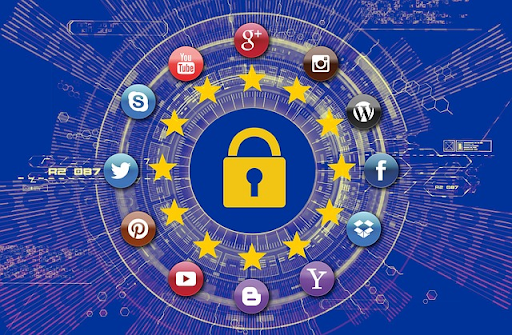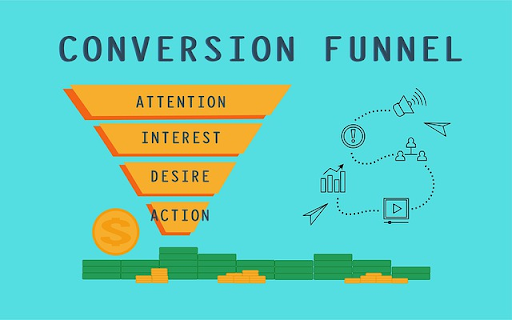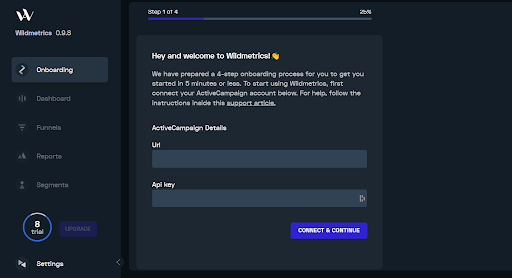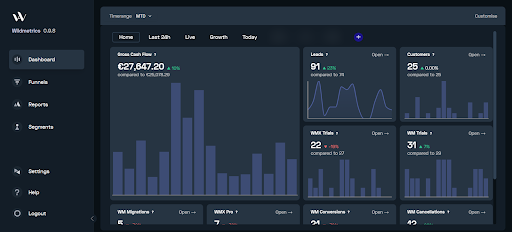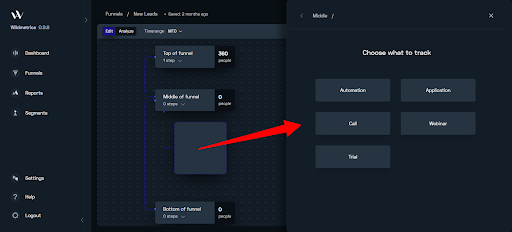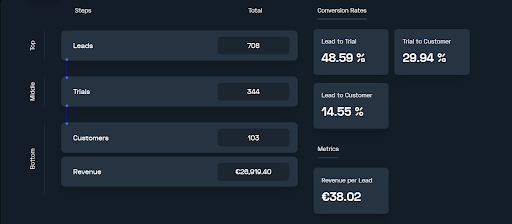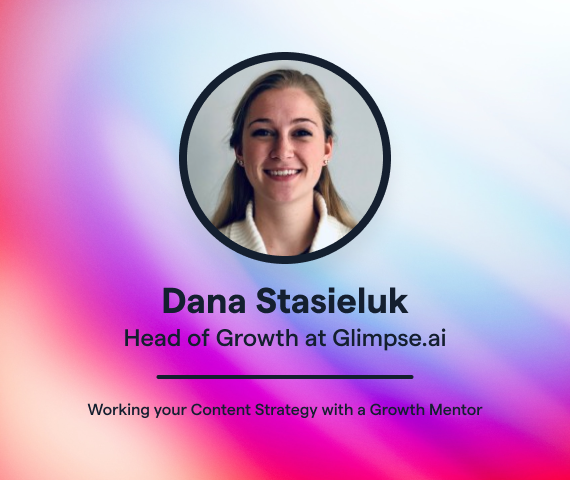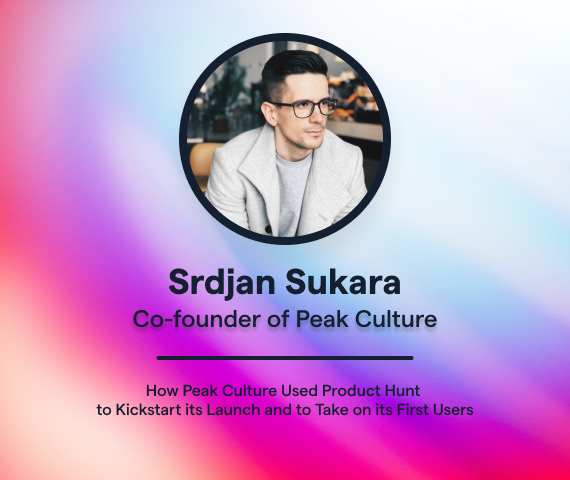How to track your marketing efforts in a cookieless world (without wasting time on Google Sheets)
Love them or hate them, third-party cookies have been a part of our everyday internet experience for years.
At Wild Audience, cookies have been a crucial part of our success helping businesses build more authentic relationships with their audience using marketing automation.
And if you’re doing any kind of marketing or advertising…
Chances are you’ve relied on them, too.
Because successful businesses don’t just pray for results:
We track our customer journeys and know our numbers so we can make data-driven decisions to grow.
But that’s about to get a lot more difficult in 2023 with the start of a cookieless world.
In this article, you’ll learn what this cookieless future is, what it means for your business, and how to track your funnels without third-party cookies to achieve consistent growth and predictable revenue…
And at the end, we’ll have a toolkit for you to get started with your own preparations.
Let’s dive in!
What is a “cookieless” world?
In 2020, Google published an article sharing their plans to make third-party cookies obsolete by 2022.
They’ve also vowed to crack down on “fingerprint tracking” (used by platforms like Hyros) which undermines cookie controls, lacks transparency, and fails to respect internet users’ choice.
After pushback from marketers and advertisers whose funding was significantly decreased during Google’s initial cookie-blocking tests, Google extended the phaseout to 2023.
This ends the era of targeted marketing and advertising relying on this form of tracking.
In the meantime, they continue to work on providing effective alternatives for tracking and analytics to avoid crippling publishers, businesses, and the web as a whole.
So, what does this mean for your business?
“It will likely take many years for a stable environment that balances standards-based data-driven advertising and consumer privacy to emerge,” says Eric Schmitt, Senior Director Analyst at Gartner.
“Marketing leaders responsible for ad budgets, media mix, planning and measurement will need to adjust strategies as Google rewires its data policies, ad products and capabilities against a backdrop of new privacy norms and elevated antitrust dynamics.”
Luckily, there’s a way to collect first-party (and even zero-party) data so you can continue serving your audience relevant ads and content such as Top of Funnel, Middle of Funnel or Bottom of Funnel content.
More on that in a minute, but first…
Why is first-party data valuable to your business?
First, let’s look at the different kinds of data available to marketers, advertisers, and business owners:
- First-party data (1PD) is information collected directly from your audience’s engagement with your brand via marketing campaigns, success measures, and support interactions, and includes events like purchases, downloads, clicks, browsing behavior, and more. It’s available from sources like your own customer relationship management software (CRM), email marketing software (EMS), social media account, or website – not from a third-party source.
- Second-party data (2PD) is simply someone else’s 1PD. This might be another business in your industry, for example, who sells you their analytics. While 2PD can help fill gaps in your own data, it cannot replace data about your specific audience collected on your own platforms.
- Third-party data (3PD) is any data you acquire that’s not your own and typically comes from a data aggregator. Data aggregators collect analytics from multiple companies and compile it into a single set that they sell to help businesses improve their first-party data for more accurate targeting.
Finally, there’s lesser-known zero-party data (0PD), a subset of 1PD Forrester Research defines as:
“Data which a customer intentionally and proactively shares with a brand. It can include preference center data, purchase intentions, personal context, and how the individual wants the brand to recognize [them].”
We’ve leveraged this effectively for years in our Respect-Based Marketing strategies and Relationship Funnel via quizzes, surveys, frequency selectors, and more.
The main advantage of 0PD and 1PD is it helps explain the customer journey from the top of your specific funnel (TOFU) to a conversion at the bottom of your specific funnel (BOFU) in ways external data can’t.
As a result, you can trust these analytics for invaluable insights into your customers’ behavior, interests, and goals…
All information leading to more targeted marketing, content, and advertising campaigns, as well as more relevant product or service offerings.
And this advanced personalization isn’t just a “nice-to-have”:
These efforts see up to a $20 return on every $1 invested according to a study by The Relevancy Group and Liveclicker.
Now that you know the differences between data types…
How do we access the goldmine of zero- and first-party data without the “underground” methods frowned upon by Google for their intrusion on user privacy?
What do we need to track marketing metrics?
Before we dig into the specific API-based methods you can use to track your marketing efforts…
It’s important you have a foundational Tagging System in place.
You’ll need this regardless of how you plan to organize and display your data, as it’ll create data points for each of the different types of engagement your audience has with your brand.
Here are the main tag prefixes we use in our tagging taxonomy at Wild Audience:
- Action: It shows you how, where, or what the lead has done.
(ACTION: Lead Magnet Downloaded) - Events: Some event that has happened after registering.
(EVENT: Webinar visit) - Status: It tells you if something specific has happened to the lead’s relationship to your business.
(STATUS: Customer) - Segment: If you segment your list through surveys, for example, you can classify it by segments.
(SEGMENT: B) - Purchase: Indicates which product the customer purchased.
(PURCHASE: Product A)
These prefixes may change based on your specific business…
But the takeaway is this:
You need to create a naming system that serves the data you want to see from TOFU to BOFU, store it somewhere for your entire team to reference, and update it consistently.
This system will enable you to unify your data in one place, make sense of it, and make decisions based on it to grow your business later on.
Keep reading to get your copy of our Tagging System inside the Cookieless Tracking Toolkit.
What marketing metrics do we want to track?
The short answer?
Everything related to your customer journey.
Remember, you’ll need to rely more on 0PD and 1PD in a cookieless world…
So you might as well track all relevant customer interactions so you have that data when making decisions on how to adjust your campaigns and funnels.
While you’ll need to adjust for your specific business model…
Here’s an overview of what we track in a traditional funnel:
Top of the Funnel (TOFU)
- Traffic sources (channel, campaign, ad group)
There’s a hack you can use to bridge the world of UTMs and cookieless tracking that allows you to pass UTM parameters into your CRM as tags for reporting. We share it in our List Optimization Blueprint which you can get at the end of this article. - Segmentation (individual preferences for color, communication channel, frequency, industry type, business type, size, etc.)
- Number of leads
- Frontend offer (tripwire) purchases
- Lead magnet download
Middle of the Funnel (MOFU)
- Lead behavior (clicks, engagement, lead scoring)
- Customer journey (Email sequences/Automations)
- Conversion events (webinar registration, sales calls, qualification forms, trials, applications…)
Bottom of the Funnel (BOFU)
- Product purchase (including downsell, upsell, bump)
- Other conversion (partnership closed, collaboration scheduled)
- Track customer journey (downgrade, upgrade, cancellation)
- Track revenue generated
- Track ROAS
Now, I know you might be thinking:
Jason, that would be a ton of tags for our business. Isn’t this overkill?
And if you’re reporting the old way which I’m about to show you, I can understand where you’re coming from.
But remember:
Each tag provides data directly from your customers’ interactions with your business, which
- gives you highly-detailed insights into their journey and
- helps inform your marketing and advertising…
So you don’t want to be left with blind spots in your analytics.
With that, let’s look at the old way to handle reporting.
How do marketing teams usually collect and share data?
Picture this:
You or your clients have Facebook Ads Manager, your CRM, Google Data Studio, Google Analytics, Stripe, Paypal…
And it’s reporting day. Yikes.
For some businesses it’s a mad scramble to get all data from separate platforms into a Google Sheet…
For others, they’ve hired a team of data scientists…
And even for those companies with their own systems in place, it’s still a manual process that allows for human error.
But it’s not your fault.
In fact, when we operated as an agency in the past, we fell victim to this, too:
We’d take one, sometimes even two full days to pull out all the numbers from our clients’ various platforms to organize them into one Google Sheet that then took another couple of hours just for their CMO or CEO to make sense of all the rows and columns – exhausting.
The old way required:
- Installing tracking pixels
- Wasting time with GSheet or Excel formulas
- Managing UTM tags
- Getting lost in tag managers
- Hiring an analytics specialist or agency
There simply wasn’t a better option…
And despite all the effort, it still resulted in dispersed data from multiple sources and the need for manual data correlation.
But you already have tons of data inside the tools you currently use. You just need a way to easily access it from different platforms and see it in one place.
Enter:
No-code cookieless tracking.
How to use API-based cookieless tracking for your marketing analytics instead
A new digital landscape without third-party cookies calls for a new method of tracking that’s reliable and less-intrusive on user privacy…
But that still delivers actionable insights about your audience.
API-based tracking helps create a connection between marketing and advertising data (like the data we said we want to track above) directly from your various business tools like your CRM, EMS, or website server.
This data is what leads to enhanced personalization and ad or content relevancy.
By using an API-based cookieless tracking method:
- You’re not affected by IOS 14 and IOS 15.
- You don’t rely on pixels or third-party cookies.
- You save maintenance time.
- You can correlate data easily and quickly.
- You have a reliable and accurate data acquisition source.
Now, there are different ways to set this up, including custom-coded solutions or complex webs of API integrations…
But we’re fans of simple, quick, and cost-effective solutions 🙂
So in this example, I’ll show you how we use our no-code, API-based tracking tool Wildmetrics to track the customer journey in ActiveCampaign for our SaaS company.
And if you read ‘til the end…
We’ll also share our Cookieless Tracking Toolkit with you.
Note: While the interface might look different with other tools, the underlying concept remains the same. Just remember to consider the source of your data – a platform still using pixel analytics pulls from a less-reliable source than one using server-side, API-based data like Wildmetrics.
Step 1: One-Click Integration with your business tools
- By simply clicking Connect and entering in our API key and URL, we’re now pulling in all data from our CRM/EMS (ActiveCampaign).
- Next, we’ll do the same with our payment processor, Stripe
Step 2: Define customer segment with Stripe or tag & revenue value
- Inside Segments, we’re going to define our Customer segment using our Purchase or Conversion tag
- If your payment processor is not available for one-click integration, we set a revenue value for the Purchase tag to track this data inside our visual Funnels and Dashboards.
Step 3: Create segments for main conversion events (calls, webinars etc..)
- Remember the MOFU analytics we shared above? It’s time to create segments based on those tags in order to pull this data into our visual Funnels and Dashboards, too.
This way, we’ll be able to track KPIs like conversion rate at each step of the funnel, as well as “Lead to Purchase”.
Step 4: Set-up main KPI dashboard tabs
- Making sense of your data shouldn’t be complex or time-consuming. In fact, we want to empower decision makers with the ability to analyze their main KPIs in a morning “coffee check”.
To do that, your cookieless tracking tool should show them their numbers visually in easy-to-understand graphs and charts.
Using our Segments created in previous steps, we’ll build out dashboards for Home, Last 24hrs, Live, and typically a team-specific (e.g. Growth) or product-specific dashboard (e.g. your main offer).
Step 5: Set-up funnels for customer journeys
- Finally, we want to see key metrics like conversion rate or revenue per lead not only for our overall marketing activities, but also for individual product funnels and growth efforts.
Again, this should be displayed clearly in a visual way that’s easy to analyze, yet flexible enough to track the exact customer behavior you’re looking for at each stage of the funnel.
You’ll see how this allows us to track leads, trials, and customers for our SaaS company in step 6…
And you can do the same with calls, webinars, applications, and more depending on your business.
Step 6: Actionable reporting connected to your marketing campaigns and automations
- You shouldn’t need to export any of your data to sort, filter, or generate a custom report. Tools like Wildmetrics unify your data in one place, so you can see what you need to tweak at a glance so you can generate more revenue.
- Once you’ve analyzed your data, you should be able to dive deeper into specific contacts and their interactions with your campaigns…
Then take immediate action on insights gained by jumping into your EMS to adjust the specific automation or marketing campaign. It’s no use having the data if you don’t use it to improve your marketing efforts.
Next Steps for Successful Cookieless Tracking
Now that you understand more about how API-based tracking can help you prepare for the massive changes to your business’ marketing and advertising…
Here are your best next steps to getting started:
1. Make sure you have a clear, consistent Tagging System
Get this in place regardless of your CRM or EMS.
2. Find a no-code, API-based tracking solution that fits your business.
Using ActiveCampaign? Wildmetrics is free.
Check it out here and book a demo below to get your Cookieless Tracking Toolkit.
Using a different CRM or EMS? You’ll likely have to use a more custom solution by connecting your business tools using Zapier or Make (Integromat).
Google “[your CRM/EMS] no-code API-based tracking” to find their API documentation.
Chances are you’ll still be sending the data into a Google Sheet unless you find a platform that will display the data visually for you.
3. Need a hand with your initial setup?
GrowthMentor has hundreds of mentors with expertise in specific CRMs, integrations, and automation software.
If you’re using ActiveCampaign, our team at Wild Audience can help you set up tracking and reports for your data in less than 45 minutes:
Book a demo here and we’ll share our Cookieless Tracking Toolkit, which includes:
- Our fill-in-the-blank Tagging System
- Our step-by-step List Optimization Blueprint
- A free Wildmetrics success call with done-with-you dashboard and funnel analytics setup
